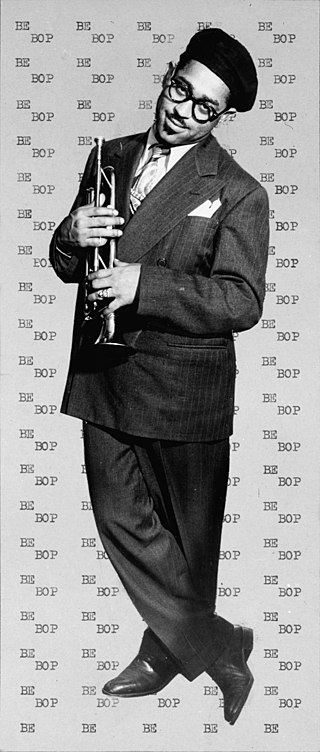
Bebop (Bop) 1
Bebop, sometimes referred to as bop, was an influential jazz style that emerged in the early 1940s at the end of the Swing Era. Bebop was particularly associated with Black musicians, prominent among whom were trumpeter John Birks "Dizzy" Gillespie, alto saxophonist Charlie "Yardbird" Parker, pianists Thelonious Monk and Bud Powell, drummer Kenny Clarke, and many others. Fundamental to later developments in jazz, bebop signaled an intention to move jazz away from the popular culture of the day and closer to the intellectual status accorded to art music.
According to several oral histories, the terms "bebop" and "bop" were first linked to Dizzy Gillespie's onomatopoetic verbalization of the music. Syllabic phonemes common in jazz by the early 1940s-be, doo, dee, da, bop, and others-stem from scat vocals of the 1920s and early 1930s, such as Louis Armstrong's vocal improvisations on his recordings of "Heebie Jeebies" (starting at 01:48) and "West End Blues" (starting at 01:25). By the 1930s, Cab Calloway and others had crafted entire performance approaches around such sounds (for example, the song "Zah Zuh Zah," 1933). Gillespie and other early beboppers performed in Calloway's group, providing an essential link to the emergence of syllabic phonemes in early bop culture. Combined with humor and irony, such onomatopoeiaWords that phonetically sound like its action such as boom, zap, or tick-tok helped to codify "bebop" within the jazz press.

Dizzy Gillespie, at the Downbeat Club, NYC, ca 1947
Although bebop had become part of mainstream jazz conversations by the mid-1940s, it initially developed on the margins of the New York jazz scene. After-hours jam sessions in Harlem and Midtown Manhattan acted as social laboratories for musicians to explore ideas that departed from the codified expectations of swing.
The most important jam sessions of the 1940s were held at Monroe's Uptown and the musician-owned Minton's Playhouse (shown here with Thelonius Monk, Howard McGhee, Roy Eldridge, and Teddy Hill). Both small cabaret-style jazz clubs in Harlem catered to musicians and a devout clientele interested in intimate performances. Pianist Thelonious Monk and drummer Kenny Clarke led the "house" trio at Minton's. In addition, older, more established musicians such as Coleman Hawkins, Lester Young, Mary Lou Williams, and others participated in these jam sessions, providing critical inter-generational influences that rooted bebop innovation within a larger historical framework.
Heebie Jeebies
Say, I've got the Heebies
I mean the Jeebies
Talking about
The dance, the Heebie Jeebies
Do, because they're boys
Because it pleases me to be joy
Boogie Woogie Bugle Boy
He was a famous trumpet man from out Chicago way
He had a boogie style that no one else could play
He was the top man at his craft
But then his number came up and he was gone with the draft
He's in the army now, a blowin' reveille
He's the boogie woogie bugle boy of Company B





